|
• INSCRIPTION PHOTOGRAPHS •
|
| PAVING TILES / INSCRIBED BRICKS |
|
|
-- Ashur-nasir-pal II
|
|
|
|
| Inscribed floor tile fragment (upper left corner of cuneiform inscription; part of 3 lines visible).
Cuneiform transcription:
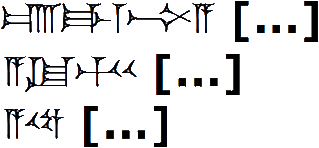
Text tranliteration:
É.GAL m.AŠ-PAB-A [MAN ŠÚ MAN KUR AŠ]
A TUKUL-MAŠ MAN [ŠÚ MAN KUR AŠ]
A10-ÉRIN.[TÁH MAN ŠÚ MAN KUR AŠ-ma]
Text Translation:
"(Property of) the palace of Ashurnasirpal, [king of the universe, king of Assryia,] son of Tukultī-Ninurta (II), king [of the universe, king of Assyria,] son of Adad-[nārārī (II) (who was) also the king of the universe and king of Assyria.]" (trans. RIMA 2, p. 368, text A.0.101.115; research by Elizabeth Payne, Yale Babylonian Collection)
|
|
Inv. # N20-74
Dimensions: W = 32cm; H = 23cm
Material: baked clay
Date: Ashur-nasir-pal II, 883-859 BCE
Provenance: North Area
(click here to enlarge the photo and the drawing; hover over the photo and plan to zoom)
|
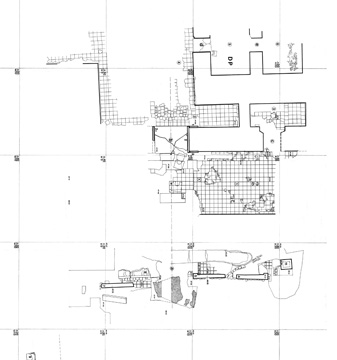 |
|
|
|
|
|
|
|
|
| Inscribed floor tile fragment (3 lines of cuneiform text, with guidelines; one side inscribed also--see below, #N24-74); upper and right side are original. The last sign of the first line is compressed and indistinctly engraved.
Cuneiform transcription:
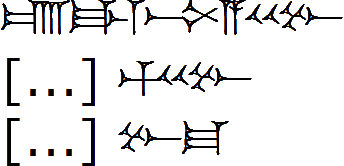
Text transliteration:
É.GAL m.AŠ-PAB-A MAN KUR AŠ
[A TUKUL]-MAŠ MAN KUR AŠ
[A10-ÉRIN.TÁH MAN] KUR AŠ-ma
Text translation:
"(Property of) the palace of Ashurnasirpal, king of Assryia, [son of Tukultī]-Ninurta (II), king of Assyria, [son of Adad-nārārī (II) (who was) also the king] of Assyria." (trans. RIMA 2, p. 375, text A.0.101.125; research by Elizabeth Payne, Yale Babylonian Collection)
|
|
Inv. # N23-74
Dimensions: L = 43cm; W = 28cm; Th = 12cm
Material: baked clay
Date: Ashur-nasir-pal II, 883-859 BCE
Provenance: North Area.
(click here to enlarge the photo and the drawing; hover over the photo and plan to zoom)
|
 |
|
|
|
|
| Inscribed side of floor tile fragment #N23-74 (see above); 3 lines of cuneiform text with guidelines.
Cuneiform transcription:
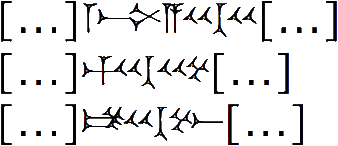
Text transliteration:
[É.GAL] m.AŠ-PAB-A MAN ŠÚ MAN [KUR AŠ]
[A TUKUL]-MAŠ MAN ŠÚ MAN KUR [AŠ]
[A10-ÉRIN].TÁH MAN ŠÚ MAN KUR AŠ-[ma]
Text translation:
"(Property of) t[he palace] of Ashurnasirpal, king of the universe, king of [Assryia,] [son of Tukultī]-Ninurta (II), king of the universe, king of [Assyria,] [son of Adad]-nārārī (II) (who was) [also] the king of the universe and king of Assyria." (trans. RIMA 2, p. 368, text A.0.101.115; research by Elizabeth Payne, Yale Babylonian Collection)
|
|
Inv. # N24-74
Dimensions: L = 43cm; Th = 12cm
Material: baked clay
Date: Ashur-nasir-pal II, 883-859 BCE
Provenance: North Area.
(click here to enlarge the photo and the drawing; hover over the photo and plan to zoom)
|
 |
|
|
|
|
| Inscribed floor tile fragments belonging to the reign of Ashur-nasir-pal II (portions of 3 lines of cuneiform text on the edge of each).
Cuneiform transcription (upper left fragment):
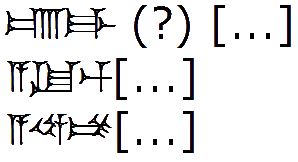
Text transliteration (upper left fragment):
É.GAL(?) [m.AŠ-PAB-A ... ]
A TUKUL-MAŠ [...]
A10-ÉRIN.TÁH [...]
Text translation (upper left fragment):
"(Property of) the palace (?) of [Ashurnasirpal ...], son of Tukultī-Ninurta (II), [...], son of Adad-nārārī (II) [...]" (this text presumably begins E2.GAL, but the reading--particularly of the GAL-sign--is uncertain, as is the titulature of kings, which is broken; generally similar to trans. RIMA 2, p. 375, text A.0.101.125; research by Elizabeth Payne, Yale Babylonian Collection)
Cuneiform transcription (middle right fragment):
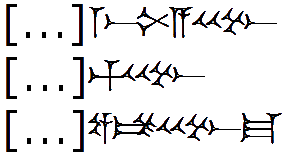
Text transliteration (middle right fragment):
[É.GAL] m.AŠ-PAB-A MAN KUR AŠ
[A TUKUL]-MAŠ MAN KUR AŠ
[A10]-ÉRIN.TÁH MAN KUR AŠ-ma
Text translation (middle right fragment):
"(Property of) [the palace] of Ashurnasirpal, king of Assryia, [son of Tukultī]-Ninurta (II), king of Assyria, [son of Adad]-nārārī (II) (who was) also the king of Assyria." (trans. RIMA 2, p. 375, text A.0.101.125; research by Elizabeth Payne, Yale Babylonian Collection)
Cuneiform transcription (lower left fragment):
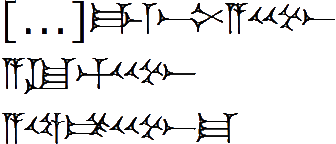
Text transliteration (lower left fragment):
[É.GAL] m.AŠ-PAB-A MAN KUR AŠ
A TUKUL-MAŠ MAN KUR AŠ
A10-ÉRIN.TÁH MAN KUR AŠ-ma
Text translation (lower left fragment):
"(Property of) [the palace] of Ashurnasirpal, king of Assryia, son of Tukultī-Ninurta (II), king of Assyria, son of Adad-nārārī (II) (who was) also the king of Assyria." (trans. RIMA 2, p. 375, text A.0.101.125; research by Elizabeth Payne, Yale Babylonian Collection)
|
|
Inv. # N25-74
Dimensions: L = 37cm; W = 37cm; Th = 12cm (fragment 'c')
Material: baked clay
Date: Ashur-nasir-pal II, 883-859 BCE
Provenance: North Area.
(click here to enlarge the photo and the drawing; hover over the photo and plan to zoom)
|
 |
|
|
|
|
| Inscribed floor tile fragment (3 lines of cuneiform text); upper and left edge original.
Cuneiform transcription:
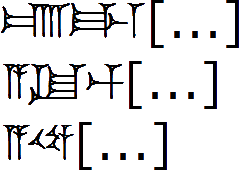
Text transliteration:
É.GAL m.[AŠ-PAB-A ...]
A TUKUL-MAŠ [...]
A10-ÉRIN.[TÁH ...]
Text translation:
"(Property of) the palace of [Ashurnasirpal, ...], son of Tukultī-Ninurta (II), [...], son of Adad-[nārārī (II) ...]." (research by Elizabeth Payne, Yale Babylonian Collection)
|
|
Inv. # N27-74
Dimensions: L = 34cm; W = 28cm; Th = (not provided)
Material: baked clay
Date: Ashur-nasir-pal II, 883-859 BCE
Provenance: North Area.
(click here to enlarge the photo and the drawing; hover over the photo and plan to zoom)
|
 |
|
|
|
|
| Badly worn inscribed paving brick with 3 lines of cuneiform text.
Text transliteration:
É.GAL {m}aš-šur-A MAN KUR aš-šur?
A TUKUL-MAŠ MAN KUR aš-šur?
A 10-ERIM.TÁH MAN KUR aš-šur?-ma?
Text translation:
“Palace of Ashurnasirpal (II), king of Assyria, son of of Tukultī-Ninurta (II), king of Assyria, son of Adad-nārārī (II), (who was) also king of Assyria.” (Duplicate of RIMA 2, pp.366-368, no. 115; research by Jamie Novotny, University of Pennsylvania)
|
|
Inv. # VE18-74
Dimensions: not specified
Material: most likely baked clay
Date: Ashur-nasir-pal II, 883-859 BCE
Provenance: not specified
(click here to enlarge the photo or hover over the photo to zoom)
|
|
|
|
|
|
Worn and cracked, inscribed paving brick with 6 lines of cuneiform text readable.
Text transliteration:
1. [É.GAL {m}aš-šur-PAP-A MAN GAL-ú]
MAN dan-nu MAN ŠÚ MAN KUR aš-šur A TUKUL-MAŠ
MAN GAL-e MAN dan-ni MAN ŠÚ MAN KUR aš-šur
A 10-ERIM.TÁH MAN ŠÚ MAN KUR aš-šur-ma
ki-sir-tú
ša TÙR É.GAL
Text translation:
“[Palace of Ashur-nasir-pal (II), great king], mighty king, king of the world, king of Assyria, son of Tukultī-Ninurta (II), great king, mighty king, king of the world, king of Assyria, son of Adad-nārārī (II), (who was) also king of Assyria: facing slab of the courtyard of the palace.” (Duplicate of RIMA 2, pp.355-356, no. 102; research by Jamie Novotny, University of Pennsylvania)
Inv. # VE22-74
Dimensions: not specified
Material: most likely baked clay
Date: Ashur-nasir-pal II, 883-859 BCE
Provenance: not specified
(click here to enlarge the upper photo, the lower photo, or hover over the photo to zoom; note that the lower context photo is upside down)
|
|
|
|
Very worn and broken, inscribed paving brick with possibly 5 lines of cuneiform text barely readable (possible translation below).
Text transliteration:
[É].GAL {m}aš-šur-PAP-A MAN ŠÚ
MAN KUR aš-šur A TUKUL-MAŠ MAN ŠÚ
MAN KUR aš-šur A 10-ERIM.TÁH MAN ŠÚ
MAN KUR aš-šur-ma ki-sir-tú
[ša] TÙR É.GAL
Text translation:
“Palace of Ashur-nasir-pal (II), king of the world, king of Assyria, son of Tukultī-Ninurta (II), king of the world, king of Assyria, son of Adad-nārārī (II), (who was) also king of Assyria: facing slab of the courtyard of the palace.” (Duplicate of RIMA 2, pp.355-356, no. 102, shorter version of the text; research by Jamie Novotny, University of Pennsylvania)
Inv. # VE23-74
Dimensions: not specified
Material: most likely baked clay
Date: Ashur-nasir-pal II, 883-859 BCE
Provenance: not specified
(click here to enlarge the photo or hover over the photo to zoom)
|
|
|
|
Very badly worn and broken, inscribed paving brick with several lines of cuneiform text that cannot be entirely read.
Text transliteration:
|
|
|
-- Shalmaneser III
|
|
|
|
Inscribed clay tile fragment (3 lines of cuneiform text are preserved; right edge is original; see also N5-76 and N22-74 below).
Text Transliteration:
[md.šùl-ma-nu-MAŠ MAN GAL-ú]
[MAN dan-nu MAN ŠÚ MAN KUR AŠ]
[A m.AŠ-PAB-A MAN GAL-ú]
[MAN dan-nu MAN ŠÚ MAN KUR AŠ]
[A m.TUKUL-MAŠ MAN ŠÚ MAN] KUR AŠ-ma
[ri-sip-tú U6].NIR
[šá URU] kal-[hi]
Text translation:
"[Shalmaneser, great king, strong king, king of the universe, king of Assyria, son of Ashurnasirpal (II), great king, strong king, king of the universe, king of Assyria, son of Tukultī-Ninurta (II), (who was) also king of the universe] and king of Assyria: [construction of the ziqqur]rat [of] Cal[ah]." (trans. RIMA 3, p. 168, text A.0.102.111; research by Elizabeth Payne, Yale Babylonian Collection)
Inv. # N21-74
Dimensions: max. W = 20cm; H = 47cm
Material: baked clay
Date: Shalmaneser III 859-824 BCE
Provenance: North Area
(hover over photo to zoom; click here to enlarge the photo)
|
|
|
|
Inscribed floor tile with 5 lines of readable cuneiform text pertaining to the construction of the ziggurat (see also N21-74 above and N5-76 below).
Cuneiform transcription:
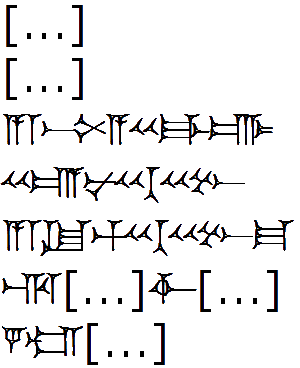
Text tranliteration:
[md.šùl-ma-nu-MAŠ MAN GAL-ú]
[MAN dan-nu MAN ŠÚ MAN KUR AŠ]
A m.AŠ-PAB-A MAN GAL-ú
MAN dan-nu MAN ŠÚ MAN KUR AŠ
A m.TUKUL-MAŠ MAN ŠÚ MAN KUR AŠ-ma
ri-[ṣip-tú] U6.[NIR]
šá URU [kal-hi]
Text Translation:
"[Shalmaneser, great king, strong king, king of the universe, king of Assyria], son of Ashurnasirpal (II), great king, strong king, king of the universe, king of Assyria, son of Tukultī-Ninurta (II), (who was) also king of the universe and king of Assyria: con[struction] of the ziq[qurrat] of [Calah]." (trans. RIMA 3, p. 168, text A.0.102.111; research by Elizabeth Payne, Yale Babylonian Collection)
Inv. # N22-74
Dimensions: L = 35cm; W = 35cm; Th = 12cm
Material: baked clay
Date: Shalmaneser III 859-824 BCE
Provenance: from the fill in the southeast corner of the room lying north of the gate with reliefs (North Area).
(hover over the photo to zoom; click here to enlarge the photo or drawing)
|
|
|
|
Inscribed brick fragments (lines of cuneiform text mentioning Shalmaneser III and his work on the Nirmud ziggurat).
Cuneiform transcription (upper left fragment):
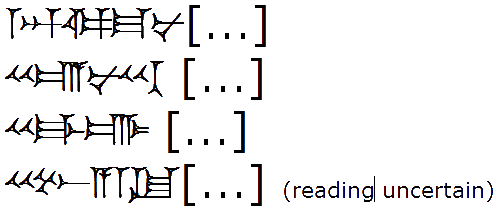
Text transliteration (upper left fragment):
md.šùl-ma-nu-[MAŠ ...]
MAN dan-nu MAN ŠÚ [...]
MAN GAL-ú [...]
MAN KUR AŠ A m.TUKUL-[MAŠ ...] (reading uncertain)
Text translation (upper left fragment):
"Shalmaneser, ... strong king, king of the universe, ... great king, ... king of Assyria, son of Tukultī-[Ninurta] (II)." (reading uncertain; research by Elizabeth Payne, Yale Babylonian Collection)
Cuneiform transcription (upper right fragment):
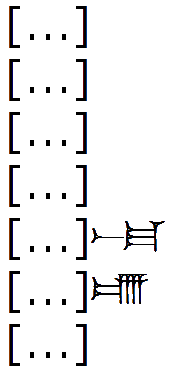
Text transliteration (upper right fragment):
[md.šùl-ma-nu-MAŠ MAN GAL-ú]
[MAN dan-nu MAN ŠÚ MAN KUR AŠ]
[A m.AŠ-PAB-A MAN GAL-ú]
[MAN dan-nu MAN ŠÚ MAN KUR AŠ]
[A m.TUKUL-MAŠ MAN ŠÚ MAN KUR] AŠ-ma
[ri-ṣip-tú U6].NIR
[šá URU kal-hi]
Text translation (upper right fragment):
"[Shalmaneser, great king, strong king, king of the universe, king of Assyria, son of Ashurnasirpal (II), great king, strong king, king of the universe, king of Assyria, son of Tukultī-Ninurta (II), (who was) also king of the universe and king of] Assyria: [construction of the ziqqur]rat [of Calah]." (trans. RIMA 3, p. 168, text A.0.102.111; research by Elizabeth Payne, Yale Babylonian Collection)
Cuneiform transcription (bottom brick):

Text tranliteration (bottom brick):
md.šùl-ma-nu-MAŠ MAN GAL-[ú]
MAN dan-nu MAN ŠÚ MAN KUR [AŠ]
A m.AŠ-PAB-A MAN GAL-ú
MAN dan-nu MAN ŠÚ MAN KUR AŠ
A m.TUKUL-MAŠ MAN ŠÚ MAN KUR AŠ-ma
ri-ṣip-tú U6.NIR
šá URU kal-hi
Text Translation (bottom brick):
"Shalmaneser, great king, strong king, king of the universe, king of [Assyria], son of Ashurnasirpal (II), great king, strong king, king of the universe, king of Assyria, son of Tukultī-Ninurta (II), (who was) also king of the universe and king of Assyria: construction of the ziqqurrat of Calah." (trans. RIMA 3, p. 168, text A.0.102.111; research by Elizabeth Payne, Yale Babylonian Collection)
Inv. # N28-74
Dimensions: upper left frag.--H = 25cm; W = 28cm; upper right frag.--H. = 25cm; W = 15cm; nearly fully preserved lower brick--H = 47cm; W = 48cm
Material: baked clay
Date: Shalmaneser III 859-824 BCE
Provenance: North Area.
(click on image to enlarge - 270k)
|
|
|
|
| Inscribed floor tile inscribed (in 2 lines of cuneiform) on the side with the name of Shalmaneser III.
Cuneiform transcription:

Text transliteration:
md.šùl-ma-nu-MAŠ MAN GAL-ú
MAN dan-nu MAN ŠÚ MAN KUR AŠ
Text translation:
"Shalmaneser, great king, strong king, king of the universe, king of Assyria."
|
|
Inv. # N29-74
Dimensions: H = 36cm; W = 36cm; Th = 12cm
Material: baked clay
Date: Shalmaneser III 859-824 BCE
Provenance: among the floor tiles situated on the main axis of the entrance in the North Area.
(hover over the photo and plan to zoom; click here to enlarge the photo or inscription drawing)
|
 |
|
|
|
|
Inscribed brick edge (with 3 lines of cuneiform) referring to the work of Shalmaneser III.
Cuneiform transcription:
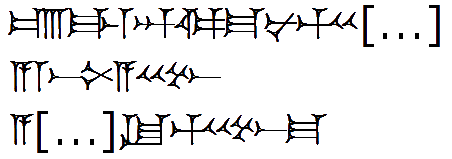
Text transliteration:
É.GAL md.šùl-ma-nu-MAŠ MAN [AŠ]
A m.AŠ-PAB-A MAN KUR AŠ
A [m].TUKUL-MAŠ MAN KUR AŠ-ma
Text translation:
"(Property of) the palace of Shalmaneser, king of [Assyria], son of Ashurnasirpal (II), king of Assyria, son of Tukultī-Ninurta (II), (who was) also King of Assyria." (trans. RIMA 3, p. 165, text A.0.102.109; research by Elizabeth Payne, Yale Babylonian Collection)
Inv. # N3-76
Dimensions: not specified; from scale, W = c.35m, H = c.11cm
Material: baked clay
Date: Shalmaneser III 859-824 BCE
Provenance: not specified
(hover over photo to zoom; click here to enlarge the photo)
|
|
|
|
Inscribed brick with 5-line inscription preserved indicating that the brick was used in the construction of the ziggurat (see also N21-74 and N22-74 above).
Cuneiform transcription:

Text transliteration:
[md.šùl-ma-nu-MAŠ MAN GAL-ú]
[MAN dan-nu MAN ŠÚ MAN KUR AŠ]
[A m.AŠ]-PAB-A MAN GAL-[ú]
[MAN dan]-nu MAN ŠÚ MAN KUR AŠ
A m.TUKUL-MAŠ MAN ŠÚ MAN KUR AŠ-ma
ri-sip-tú U6.NIR
šá URU kal-hi
Text translation:
"[Shalmaneser, great king, strong king, king of the universe, king of Assyria, son of Ashur]-nasirpal (II), great king, [strong king], king of the universe, king of Assyria, son of Tukultī-Ninurta (II), (who was) also king of the universe and king of Assyria: construction of the ziqqurrat of Calah." (trans. RIMA 3, p. 168, text A.0.102.111; research by Elizabeth Payne, Yale Babylonian Collection)
Inv. # N5-76
Dimensions: unspecified; from scale on photo W = c.35cm
Material: baked clay
Date: Shalmaneser III 859-824 BCE
Provenance: unspecified
(click here to enlarge the photo)
|
|
| SLABS |
|
|
|
| Inscribed slab (6 lines of cuneiform text); upper and left edges original. See also unidentified objects below (#N2-76).
Cuneiform transcription:
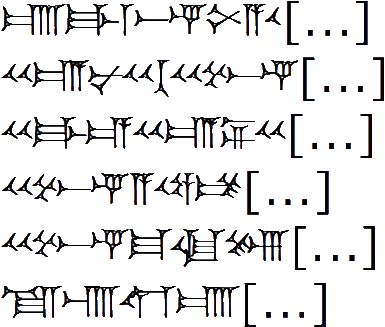
Text transliteration:
É.GAL m.aš-šur-PAB-A MA[N GAL-ú]
MAN dan-nu MAN ŠÚ MAN KUR aš-šur [A TUKUL-MAŠ]
MAN GAL-e MAN dan-ni MAN [ŠÚ]
MAN KUR aš-šur A 10-ÉRIN.[TAH]
MAN KUR aš-šur-ma ki-sir-[tú]
šá TÙR É.GAL
Text translation:
"(Property of) the palace of Ashurnasirpal, great king, strong king, king of the universe, king of Assryia, son of Tukultī-Ninurta (II), great king, strong king, king of the universe, king of Assyria, son of Adad-nārārī (II) (who was) also king of Assyria: facing slab of the palace courtyard." (trans. RIMA 2, p. 355-56, text A.0.101.102; actually a variant of that text as the line divisions on this stone slab differ from the text as presented there; research by Elizabeth Payne, Yale Babylonian Collection)
|
|
Inv. # N26-74
Dimensions: H = 46cm; W = 20cm; Th = 14cm
Material: unidentified stone
Date: Ashur-nasir-pal II, 883-859 BCE
Provenance: North Area.
(click here to enlarge the photo and the drawing; hover over the photo and plan to zoom)
|
 |
|
|
|
|
Inscribed slab fragment (lines of cuneiform text very eroded and practically unreadable); upper and left edges original.
Inv. # N30-74
Dimensions: (none recorded)
Material: stone
Date: Ashur-nasir-pal II, 883-859 BCE
Provenance: North Area.
(click on image to enlarge - 330k)
|
|
| TABLETS |
|
|
photographs lost
|
Inscribed tablet fragment (upper left corner of cuneiform tablet; part of 3 lines visible on the front, back side of one line of signs preserved).
Inv. # N16-74
Dimensions: L 2cm; W 1.7cm; Th. 1.5cm
Material: baked clay
Date: NeoAssyrian c.883-612 BCE
Provenance: found in secondary filling over the pavement in Room 1, North Area (Ashur-nasir-pal building).
(click on image to enlarge - 120k)
|
|
|
|
| Inscribed foundation tablet (25 lines on one face; 26 lines on the other); badly preserved; no translation provided. |
|
Inv. # N35-75
Dimensions: H = 0.32m; W = 0.35m; Th = 0.05
Material: Mosul alabaster
Date: Ashur-nasir-pal II, 883-859 BCE
Provenance: square S10/W30 (c.1.0m above pavement)
(hover cursor over photos or plan to zoom; click here to enlarge the top photo or the bottom photo)
|
 |
|
|
|
|
|
|
|
Inscribed stone fragments (possibly from reliefs; segments of cuneiform text visible).
Inv. # N32-74
Dimensions: various c. 10-40cm
Material: Mosul alabaster
Date: Ashur-nasir-pal II (?), 883-859 BCE
Provenance: North Area
(click on image to enlarge - 195k)
|
|
|
|
Inscribed stone fragments (possibly from reliefs; segments of cuneiform text visible).
Inv. # N33-74
Dimensions: various c.15-40cm
Material: Mosul alabaster
Date: Ashur-nasir-pal II (?), 883-859 BCE
Provenance: North Area
(click on image to enlarge - 260k)
|
|
|
|
Inscribed stone fragments (possibly from reliefs; segments of cuneiform text visible).
Inv. # N34-74
Dimensions: various c.8-28cm
Material: Mosul alabaster
Date: Ashur-nasir-pal II (?), 883-859 BCE
Provenance: North Area
(click on image to enlarge - 260k)
|
|
|
|
Inscribed stone fragments (possibly from reliefs; segments of cuneiform text visible).
Inv. # N35-74
Dimensions: various c.5-28cm
Material: Mosul alabaster
Date: Ashur-nasir-pal II (?), 883-859 BCE
Provenance: North Area
(click on image to enlarge - 230k)
|
|
|
|
| Inscribed fragment (segments of five cuneiform lines of text are visible). See also stone slab above with similar inscription (#N26-74).
Cuneiform transcription:
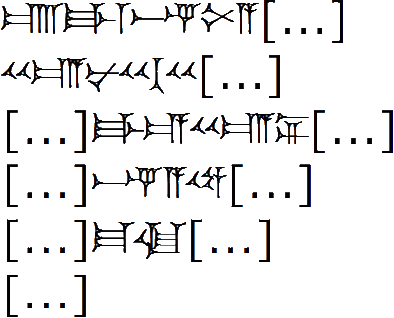
Text translitertion:
É.GAL m.aš-šur-PAB-A [MAN GAL-ú]
MAN dan-nu MAN ŠÚ MAN [KUR aš-šur A TUKUL-MAŠ]
[MAN] GAL-e MAN dan-ni [MAN ŠÚ]
[MAN KUR] aš-šur A 10-ÉRIN.[TAH]
[MAN KUR aš-šur]-ma ki-[sir-tú]
[šá TÙR É.GAL]
Text translation:
"(Property of) the palace of Ashurnasirpal, [great king], strong king, king of the universe, king of [Assryia], [son of Tukultī-Ninurta (II)], great king, strong king, [king of the universe, king of Assyria, son of] Adad-nārārī (II) [(who was) also king of Assyria: facing slab of the palace courtyard]." (trans. RIMA 2, p. 356; A.0.101.102; research by Elizabeth Payne, Yale Babylonian Collection)
|
|
Inv. # N2-76
Dimensions: unspecified (from the scale in the photo, H = c.27cm; W = c.28cm
Material: possibly stone
Date: Ashur-nasir-pal II, 883-859 BCE
Provenance: unspecified
(click here to enlarge the photo)
|
|
|
|